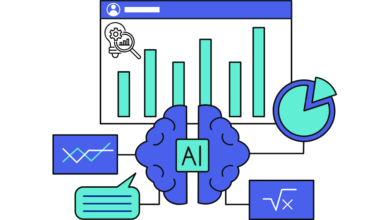The growing pervasiveness of Artificial Intelligence (AI) in society is undeniable. In a world where technology is at the service of human beings in so many ways, at work and at home, AI has become critical for making use of vast volumes of data to enable intelligent decision making and streamline personal and business activities. This is particularly true when considering business sectors such as healthcare, education, transportation or public administration, where process optimisation and service deliveries are critical.
AI across sectors
In the healthcare sector, wearable technology and IoT are enabling the collection of masses of patient data, both in and out of hospitals. Through the power of AI this data can be processed to identify patterns in patient symptoms or behaviour and make data-based decisions around patient care and hospital processes. It can be used to assist in diagnosis and lessen the burden on clinicians faced with an overwhelming amount of information, data, images, and administrative tasks. It is the core of the fast-evolving technology of digital twins and its capability to model and simulate healthcare complex environments such as human and object streams in hospitals. Here, being able to track accurate real-time location data of people and objects to feed the AI models is critical, the goal being streamlining workflows, improving patient pathway and relieving the work of the nursing staff.
In education, the promise of AI is to break down traditional grading silos and encourage a more inclusive environment. Using AI on voice, video, text in remote but also in local teaching allows learning to be adapted to each individual according to their knowledge, abilities and disabilities. ASR (Automatic Speech Recognition) for off-line or real time transcription of courses, audio processing for acoustic tailoring, NLU (Natural Language Understanding) in chatbots for knowledge management, sentiment analysis to name a few.
Digital learning platforms are the main drivers of this adoption as they embed at their core the best adapted ecosystem to collect and process the data and to deliver the value brought by AI. Here we are at the verge of the metaverse paradigm where AI is one of the building bricks for new learning environments. Avatars, remote coaching, simulated experiments, behaviour analysis are some of these new artefacts that approach our world but that still need to crystalize in Dominant Designs yet to be imagined.
At present, one AI technology that is widely deployed, and not only in the educational sphere, is chatbots. They allow immediate access to information and frequently asked questions, assist in filling in forms and scheduling appointments, as well as taking on the traditional role of switchboard.
The use cases are endless: student searching for their notes on the university webpage, researchers looking for state of the art information through Open Domain Question Answering engine coupled with virtual assistant, ASR and NLU associated on top of call centre systems to provide automatic answering for simple requests or route the call to the right agent for specific requests.
I often say, “there is no more science-fiction, only science”. We’ve reached a point where all the fiction imagined in the 70s or the 80s is now real. And one of the most obvious examples is the autonomous vehicle which brings safety, more efficient driving practices and significant time savings as people are freed from their hours currently spent at the wheel. But in the transportation area, especially in the context of urban transportation, autonomous vehicles should not be considered as closed systems but rather as nodes integrated in an aggregated network of objects, infrastructure and processes serving the city missions. The challenge here is to be able to federate all these heterogeneous AI engines for the citizen benefits. Ease traffic congestion, improve security, reduce energy consumption and lower greenhouse gas are some of the outcomes that AI promises at the condition of a global and consistent vision. For instance, AI gave life to autonomous vehicles, but what does it mean if we consider an autonomous shuttle in a city? Where and when should this kind of transportation mean be used? What would be the benefits compared to “regular” public lines? AI analysis of public video footage could improve public safety by detecting risky situations, but how should the city implement this trigger in an end-to-end decision and action chain?
AI ethics
Speaking about facial recognition, this is probably the most controversial AI technology. At first glance, it seems to bring undeniable benefits to identification procedures or the security of goods and people. For personal use, it is handy for unlocking our digital equipment. In the public sphere, it is a different story. Citizens may accept to be filmed in public places in order to guarantee their safety, but applying facial recognition is often perceived as being considered as intrusive. Here we touch on one of the most sensitive aspects of AI which is the use of personal data.
In Europe, real-time facial recognition is not allowed, and many experiments are underway where it is more about recognising an individual than identifying them. This is the case, for example, with the Prevent project, which aims to identify and locate people who have forgotten their luggage in station or airport halls. Identity is of little importance here, since the aim is to be able to warn these people in real time so that their belongings can be returned to them.
If we take the case of AI in call centres (voice biometry, voice bot), the issue is about “where is my data going? Is it stored in a safe place? Who has access to it?” And here comes all the risks linked to the Cloud AI services. In some cases, embedded AI becomes the only alternative. For example, the case of a system willing to recognise the identity of a caller based on an identification number in order to route the call to the right agent with the huge constraint of having no network access to the outside.
Yet, AI remains a very powerful technology to detect and identify fraudulent and suspicious activity on digital networks through the analysis of data and patterns, including governmental and social media profiles, achieving success far more quickly and accurately than through unassisted means. It is even possible, thanks to deep learning techniques, to detect biases in public communication and compensate them with a view to supporting inclusion and promoting the better living together.
Responsible AI
As we can see through the different examples above extracted from various sectors, AI can bring immediate and highly valuable benefits for the mankind with outcomes going far beyond what we could have imagined 40 or 50 years ago. But one must keep in mind that several risks and drawbacks come with this pervasive technology. Biases in AI decisions, security and respect of privacy of personal data and, not to mention, the digital impact of AI on the environment. AI is a powerful technology requiring powerful equipment consuming rare materials and lot of energy.
At ALE, we believe that it is the responsibility of companies to participate to the public education about the benefits but also the risks of using AI in our everyday life. This is essential not only to foster AI acceptability by users but also to get and deserve trust from them.
Our goal and social responsibility as a company is to contribute to a society where the use of AI is done with discernment. And where the trade-off between the benefits of its use and the impact on control of one’s personal data, on the environment and on free will is assessed with full knowledge of the facts, and within the limits of a regulation aimed at protecting citizens.
The benefits of AI and its pervasiveness in society are undeniable. But if adoption is going to continue to grow and if AI is to be used by the masses, doubts around ethics and responsible usage must be adequately addressed to promote transparency and trust around the use of such intelligent tools.




